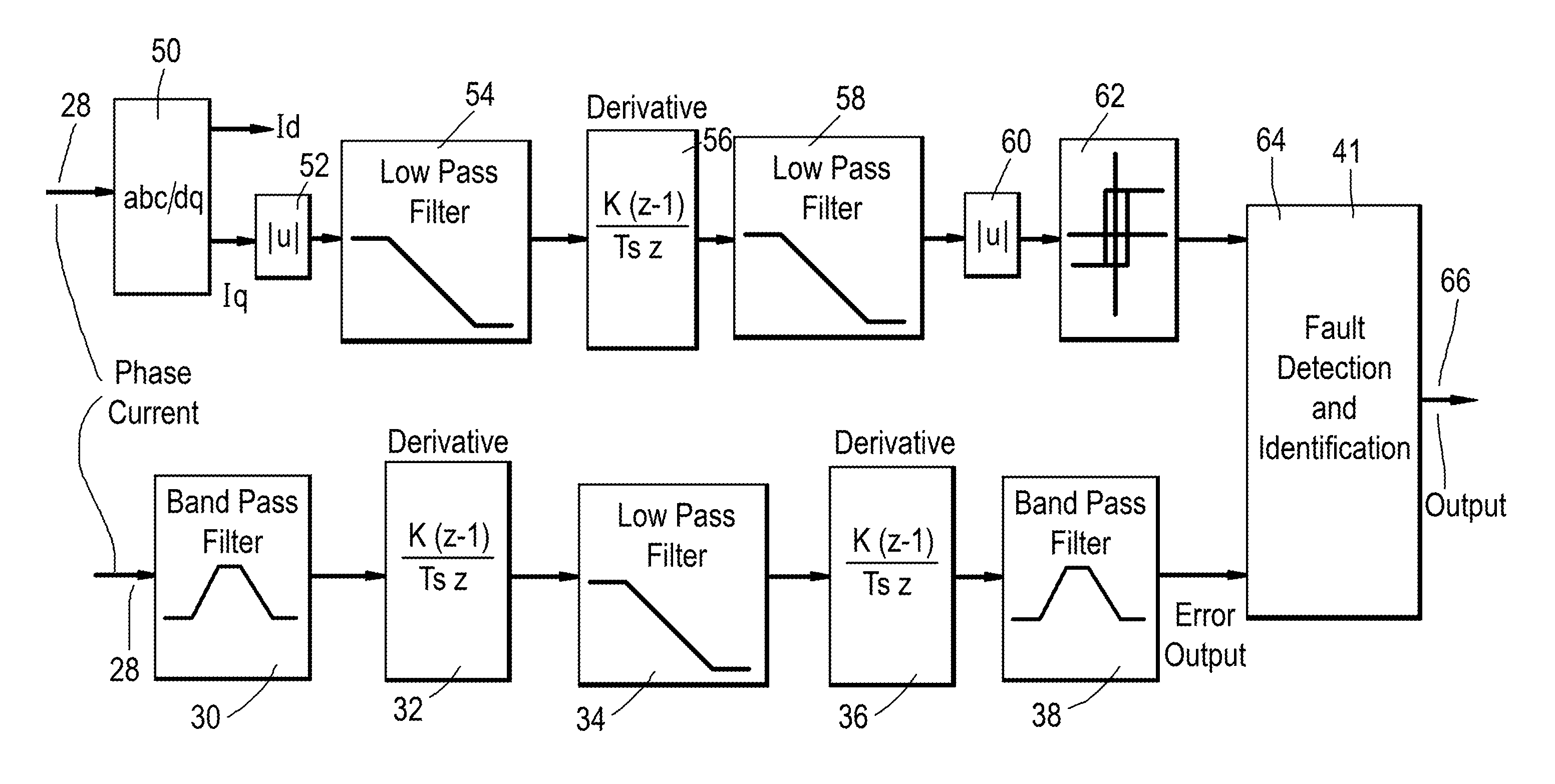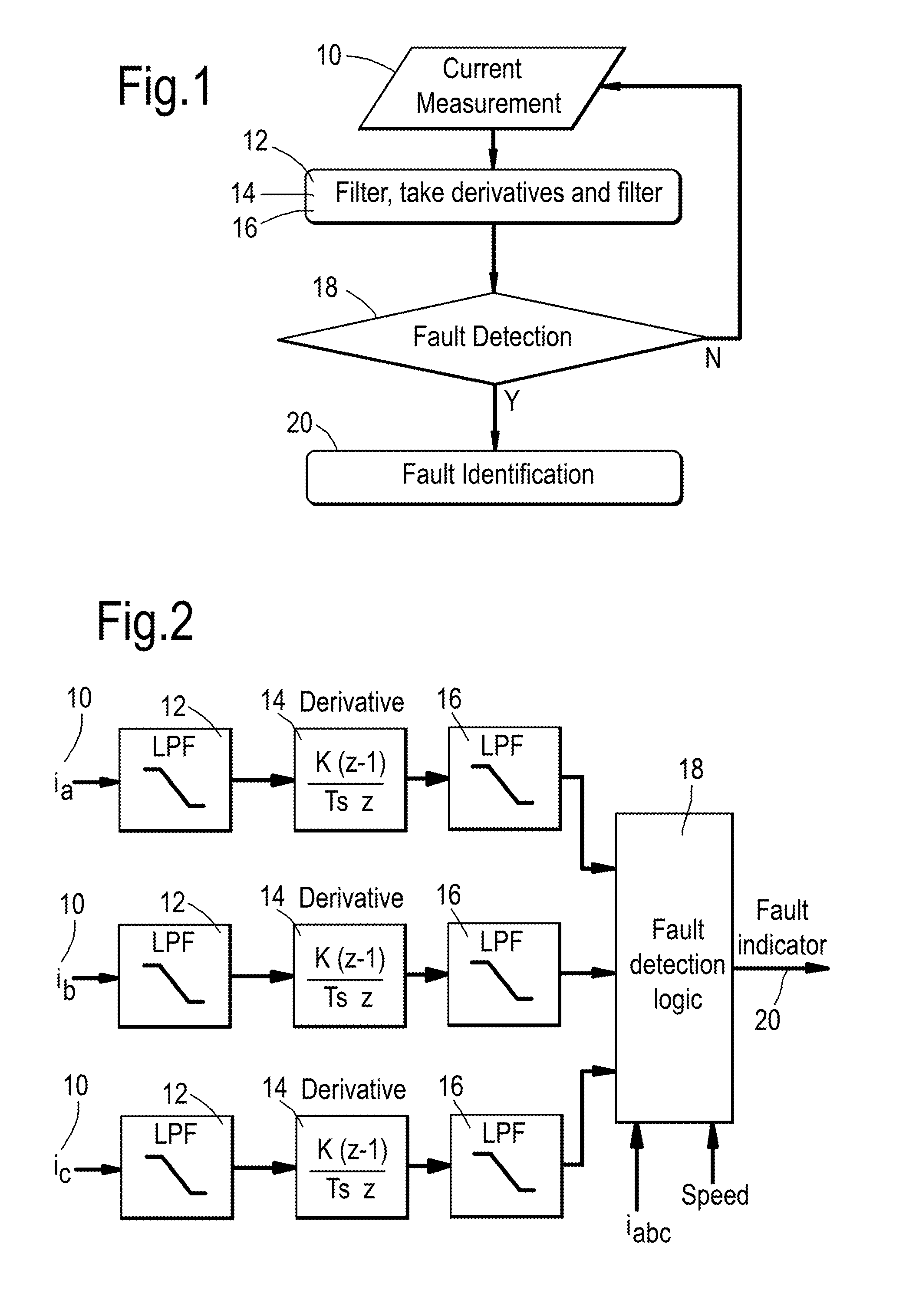Open switch fault detection and identification in a two-level voltage source power converter
a technology of open switch and power converter, which is applied in the direction of power supply testing, circuit interrupter testing, etc., can solve the problems of preventing the desired form of three-phase current from being produced, increasing operating costs, and increasing operating costs, so as to eliminate unnecessary noise and prevent false fault detection
- Summary
- Abstract
- Description
- Claims
- Application Information
AI Technical Summary
Benefits of technology
Problems solved by technology
Method used
Image
Examples
first embodiment
[0062]the method of fault detection and identification for a two-level voltage source power converter, in this case a two-level voltage source power inverter, attached to a load according to the present disclosure is described with reference to FIGS. 1 and 2.
[0063]Initially, each component of the three-phase (denoted phase A, phase B, and phase C) current outputted by the inverter (IA, IB, IC) is measured 10 using current sensors attached to each phase, and is passed through a suitable low-pass filter 12 which has a cut off frequency that is lower than the switching frequency of the inverter. The derivative of each component, IA, IB, and IC, is taken with respect to time 14, and the resulting time-derivatives are passed through a further suitable low-pass filter 16, again having a cut off frequency that is lower than the switching frequency of the inverter to the fault detection module 18. In addition to the time-derivatives, data concerning the initially measured components of the ...
second embodiment
[0078]the method of fault detection and identification for a two-level voltage source inverter attached to a load according to the present disclosure is described with reference to FIGS. 4 and 5.
[0079]Initially, each component of the three-phase (denoted phase A, phase B, and phase C) current outputted by the inverter (IA, IB, IC) is measured 28 using current sensors attached to each phase, and is passed through a suitable band-pass filter 30 with a cut off frequency lower than the switching frequency of the inverter. The band pass filter 30 has a pass frequency that is a few times higher than the fundamental frequency of the inverter, and the cut off frequency is lower than the switching frequency of the inverter. The derivative of each component, IA, IB, and IC, is taken with respect to time 32, and the resulting time-derivatives are passed through a suitable low-pass filter 34 which has a cut off frequency that is lower than the switching frequency of the inverter. The second tim...
third embodiment
[0090]the method of fault detection and identification for a two-level voltage source inverter attached to a load according to the present disclosure is described with reference to FIGS. 10 and 11.
[0091]The third embodiment of the present disclosure utilises the second embodiment of the present disclosure in combination with a further fault detection technique, which may allow for more robust and reliable fault detection. In particular, the third embodiment of the present disclosure may eliminate false fault detection which may occur as a result of harmonics of the three-phase current waveforms.
[0092]The further fault detection technique contains the following steps. Initially each component of the three-phase (denoted phase A, phase B, and phase C) current outputted by the inverter (IA, IB, IC) is measured 28 using current sensors attached to each phase The three-phase current is converted to q and d axis current 50 via a DQO transformation (i.e. a transformation to the synchronous...
PUM
 Login to View More
Login to View More Abstract
Description
Claims
Application Information
 Login to View More
Login to View More - R&D
- Intellectual Property
- Life Sciences
- Materials
- Tech Scout
- Unparalleled Data Quality
- Higher Quality Content
- 60% Fewer Hallucinations
Browse by: Latest US Patents, China's latest patents, Technical Efficacy Thesaurus, Application Domain, Technology Topic, Popular Technical Reports.
© 2025 PatSnap. All rights reserved.Legal|Privacy policy|Modern Slavery Act Transparency Statement|Sitemap|About US| Contact US: help@patsnap.com



